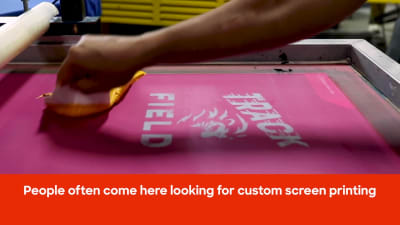Budget-Friendly T-Shirt Printing for Startups
Budget-Friendly T-Shirt Printing for Startups
Blog Article
Display Printing Uncovered: Whatever You Need to Understand About Tee Shirt and Garment Printing Strategies
If you have actually ever before asked yourself how those dynamic styles end up on your preferred tee shirts, you remain in the appropriate place. Screen printing is a fascinating technique that incorporates art with strategy, supplying countless opportunities for creative thinking. Recognizing the principles, from tools to ink choices, can significantly affect your results. Prepared to explore the necessary components that make display publishing an art kind? Let's uncover the details that can raise your projects.
The Basics of Display Printing: Exactly How It Works
When you plunge right into display printing, you'll uncover it's both a science and an art. At its core, screen printing involves developing a pattern, or display, that allows ink to pass through just in certain locations (screen printing kit). You begin by selecting your design and preparing your display with a light-sensitive solution. When you expose this emulsion to light, it hardens, leaving your style as an adverse room.
Next, you'll blend your inks and prepare your printing surface. Setting the display over the material, after that utilize a squeegee to push ink via the screen onto the garment. This process calls for precision, as you want clear, vibrant prints. After printing, you'll heal the ink with warm, ensuring it follows the fabric and lasts with laundries. Each action is essential, and grasping them will certainly elevate your display printing abilities, transforming basic garments right into distinct, meaningful items.
Kinds Of Display Printing Techniques
As soon as you grasp the essentials of display printing, it's time to explore the various methods that can raise your layouts. One preferred approach is conventional screen printing, where ink is pushed with a stenciled screen. This method is fantastic for strong, lively shades. There's water-based ink printing, which supplies a softer feeling and is environment-friendly, but it needs a various strategy to healing.
One more option is plastisol printing, understood for its resilience and vivid shades, making it a favorite for several brands. Experiment with halftone printing to create gradient impacts and intricate layouts.
Crucial Devices for Display Printing
To achieve sensational lead to display printing, having the right tools is fundamental. You'll require a durable display printing structure, which holds the mesh that transfers your style onto the garment. Next off, buy high-quality squeegees; these are necessary for applying ink uniformly throughout the screen. You'll likewise require a great exposure system to create your screens, in addition to a washout booth for cleansing them after use. A reputable heat resource, like a conveyor clothes dryer or heat press, is vital for treating your prints to ensure long life. Don't neglect an appropriate office, geared up with tables and storage for your products. Safety gear, such as gloves and masks, will certainly maintain you secure from chemicals and inks. With the right tools, you'll be well on your means to generating professional-quality prints.
Picking the Right Inks and Products
When picking inks and products for display printing, you need to take right into account the sort of ink that functions ideal for your task. Think of material compatibility to ensure your styles look last and fantastic lengthy. Also, explore environmentally friendly ink options to make your printing process extra lasting.
Kinds of Screen Inks
Picking the ideal screen ink is essential for attaining lively, resilient prints that meet your task's requirements. There are several kinds of screen inks to examine. Plastisol ink is popular for its convenience and simplicity of use, giving exceptional color opacity on dark fabrics. Water-based ink, on the various other hand, uses a softer feel and is eco-friendly, making it optimal for those looking to minimize their ecological effect. Release inks eliminate color from the material, causing a soft, classic look however require certain handling. Finally, specialized inks, such as metal or glow-in-the-dark, can include unique impacts to your styles. Examine your job demands and choose the ink that straightens best with your desired result.

Fabric Compatibility Considerations
Comprehending material compatibility is important for accomplishing premium display prints, particularly given that different materials react uniquely to various inks. When selecting inks, take into consideration the material type-- cotton, polyester, or blends. For cotton, water-based inks work well, offering soft qualities and breathability. Polyester, on the various other hand, commonly needs plastisol inks for better attachment and vivid shades. You may need to use a mix of both types if you're printing on blends. Constantly examine your inks on example material to guarantee they stick appropriately and maintain shade stability. Additionally, bear in mind that material weight and texture can influence the final outcome, so picking the best ink and material combination check that is important for your task's success.
Eco-Friendly Ink Options
Environment-friendly inks click for source are becoming a preferred selection for screen printers who desire to lessen their ecological influence while preserving high quality. When picking inks, consider water-based inks, which are much less hazardous and easier to clean up compared to typical solvents.
Additionally, search for inks made from renewable energies, such as soy or vegetable-based alternatives. By choosing the appropriate inks and materials, you'll not just create magnificent styles yet additionally add to an extra lasting printing process. Make the switch, and your prints will certainly mirror your dedication to the atmosphere!
Preparing Your Style for Screen Printing

Submit Format Demands
To assure your design looks lively and sharp on material, you'll need to pay close focus to submit format needs for display printing. Make certain your layout has a clear history to stop unwanted white sides on your prints. Keep color settings in mind; CMYK is standard for display printing, so transform your RGB makes as necessary.
Shade Splitting Up Methods
Shade splitting up is an essential step in preparing your layout for display printing, and mastering it can significantly improve your print high quality. You'll require to damage your layout right into private colors, as each shade requires a different display throughout printing. This precision not just guarantees precise shade representation yet likewise streamlines the printing procedure.
Resolution and Size
Attaining the very best lead to screen printing begins with guaranteeing your layout has the ideal resolution and dimension. Ideally, your artwork must be at least 300 DPI (dots per inch) for sharp, clear prints. Your final product might look pixelated and unprofessional. if you make use of lower resolution.
When it concerns size, take into consideration the measurements of your print area. Layout your artwork to match the last print size, ideally developing it in the actual measurements you'll be printing. This method, you'll avoid any unforeseen scaling issues.
Constantly examine your style in both vector and raster formats. Vector graphics can be scaled without shedding quality, making them perfect for screen printing. Preparing appropriately will assure your layout looks incredible on every garment!
Step-by-Step Display Printing Process
Screen printing is a vibrant process that allows you to develop vivid layouts on numerous surface areas. To get going, you'll require a screen, emulsion, and your selected ink. Initially, prepare your display by cleaning it extensively. Next, apply the emulsion evenly and allow it completely dry in a dark location. As soon as completely dry, reveal your display to light with your layout positioned click reference on it, which will certainly harden the emulsion where the light hits, developing a pattern - screen printing kit.
After washing out the unexposed emulsion, your display is all set. Establish it up on your printing surface area and align your garment below it. Pour ink onto the screen and use a squeegee to press the ink via the pattern onto the material. Lift the screen very carefully and let the print dry. Finally, heal the ink making use of warm to ensure longevity. That's it! You have actually efficiently screen printed your layout.
Tips for Effective Display Printing Projects
While you're diving into your display printing tasks, keep in mind that preparation is essential to success. Start by collecting all your materials-- inks, mops, screens, and garments. A tidy work space aids protect against unwanted errors, so clean up before you begin.
Following, verify your art work is high-resolution and appropriately sized for your garment. Examine your screen for correct exposure and clean it extensively to prevent smudges. When blending your inks, comply with the producer's guidelines to accomplish the appropriate consistency.
Throughout printing, apply even stress with your squeegee for consistent results. Do not hurry; take your time to confirm each print fulfills your standards. After printing, allow your garments completely dry completely prior to handling or packaging them.
Last but not least, always maintain a sample of your job for future reference. This method, you can analyze your progress and improve your methods with time. Happy printing!

Frequently Asked Questions
How Long Does It Take to Establish a Display Printing Work?
Establishing a screen printing job usually takes about thirty minutes to an hour. You'll prepare the displays, mix inks, and readjust journalism. The time varies based on intricacy and experience, so remain organized!
Can I Print on Different Textile Keys In Making Use Of the Exact Same Method?
Yes, you can publish on various textile kinds making use of the very same strategy, yet you'll require to change your inks and setups. Some fabrics take in ink differently, so trying out warranties the ideal outcomes for each product.
What Prevail Blunders to Prevent in Screen Printing?
When screen printing, prevent typical mistakes like making use of the wrong ink, overlooking correct direct exposure times, or missing pre-press checks. Always test your arrangement and maintain tidy screens to assure quality outcomes each time.
How Can I Effectively Clean and Keep My Screen Printing Equipment?
To appropriately clean and keep your screen printing tools, you must regularly clean screens with proper solvents, check squeegees for wear, and assure all tools are kept dust-free and completely dry. Uniformity prevents costly repairs and boosts efficiency.
Is Screen Printing Eco-friendly Contrasted to Various Other Techniques?
Screen printing can be extra eco-friendly than other methods, specifically if you use water-based inks and eco-conscious products. By picking sustainable materials and techniques, you minimize waste and decrease your impact on the world.
Display Printing Uncovered: Every Little Thing You Need to Know About Tee Shirt and Garment Printing Methods
At its core, display printing entails creating a stencil, or screen, that allows ink to pass with just in certain locations. Placement the display over the textile, after that use a squeegee to push ink with the display onto the garment. One prominent approach is traditional display printing, where ink is pressed via a stenciled screen.When choosing inks and materials for screen printing, you require to take right into account the kind of ink that works best for your project.
Report this page